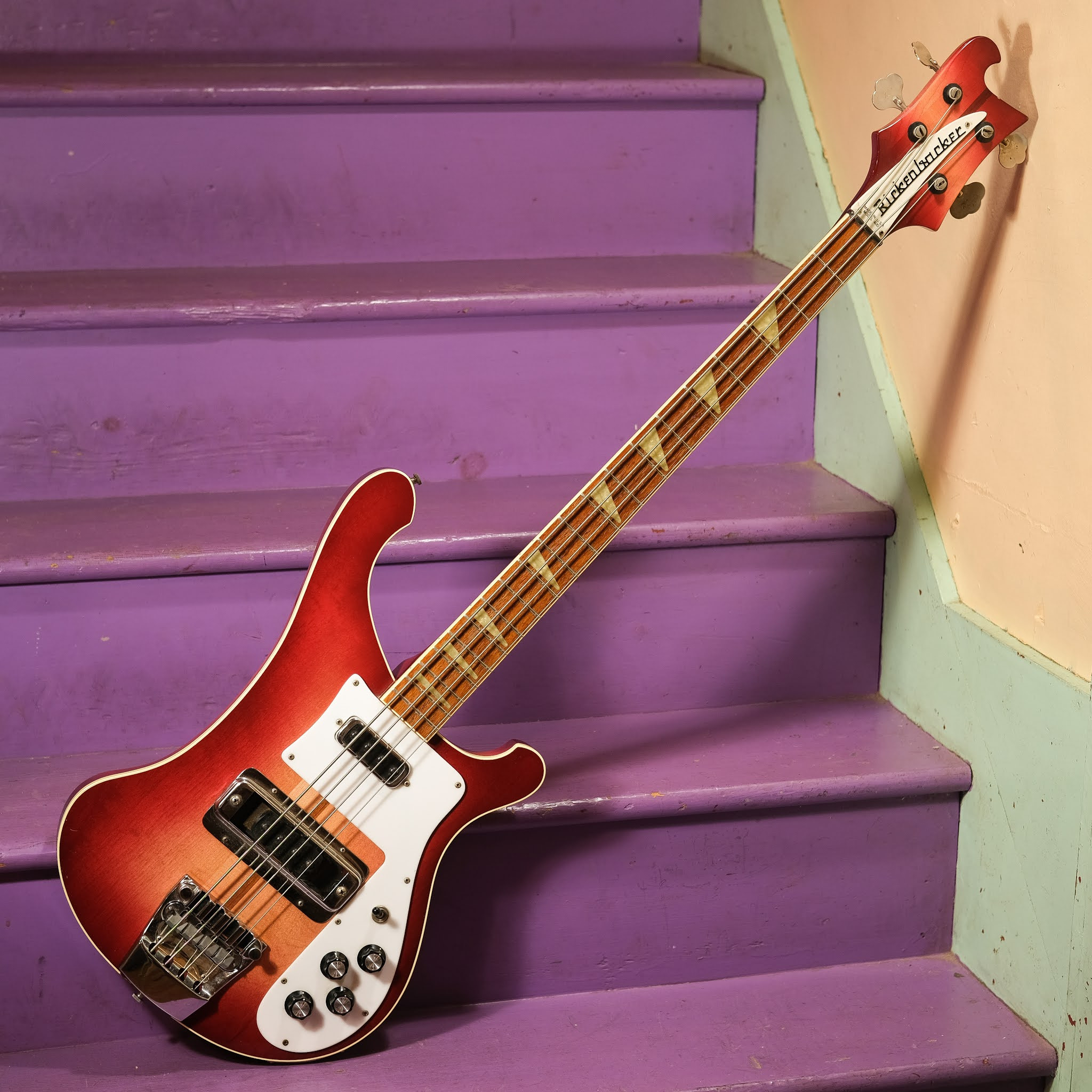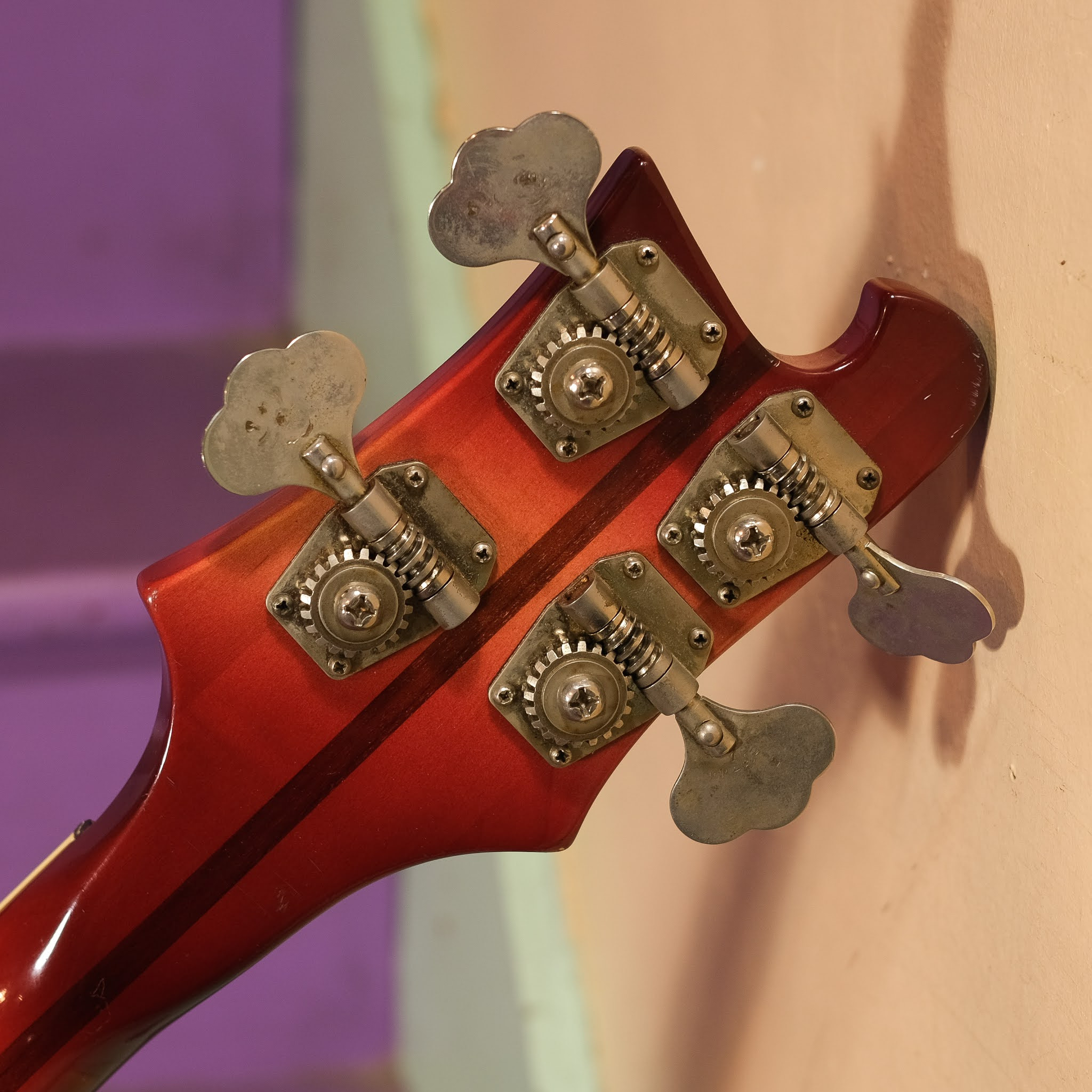The Rickenbacker 4001 Bass Guitar holds an iconic status, revered for its distinctive aesthetics, comfortable feel, and unique sonic character. These basses are highly sought after in the market, appealing to musicians who appreciate both vintage charm and exceptional performance. While a Rickenbacker 4001 truly shines when paired with high-quality amplification, revealing its full potential and rich nuances, even through modest setups, its inherent coolness and appeal remain undeniable.
Recently, a classic Rickenbacker 4001 arrived for a routine setup, but closer inspection revealed it needed more attention to restore its optimal playability. A significant issue was the misplaced bridge, hindering proper intonation. Fortunately, the guitar’s original routing provided just enough leeway to reposition the bridge slightly, about an eighth of an inch, correcting the intonation and enabling accurate action adjustment.
 Close-up of the Rickenbacker 4001 bass guitar headstock showcasing its iconic design and tuning pegs
Close-up of the Rickenbacker 4001 bass guitar headstock showcasing its iconic design and tuning pegs
Another common ailment in vintage instruments, the dreaded “ski jump” – an upward kink in the neck around the 17th to 22nd frets – was also present. This occurs over time due to the combined pressure of string tension and age, particularly where the neck joins the body. To remedy this, a fret leveling and dressing process was performed, specifically reducing the height of the affected frets to ensure smooth playability across the entire neck and eliminate fret buzz.
A more concerning discovery was a non-functional truss rod system, despite the bass featuring double truss rods. Alarmingly, as is frequently observed in approximately half of the vintage 4001s encountered for servicing, both truss rods had been excessively tightened, bowing downwards into the headstock. Attempting further adjustment risked stripping the threads or even breaking the rods. Luckily, the neck remained relatively straight up to the 12th fret, mitigating the immediate impact on playability. However, this serves as a crucial cautionary note for prospective Rickenbacker 4001 buyers: always inspect the truss rod cavity under the cover! This issue is a known vulnerability in these models.
 Detailed view of the Rickenbacker 4001 bass guitar bridge and saddle, highlighting the adjustments made for optimal string action and intonation
Detailed view of the Rickenbacker 4001 bass guitar bridge and saddle, highlighting the adjustments made for optimal string action and intonation
Beyond these specific repairs, this particular Rickenbacker 4001 was in excellent cosmetic and playing condition. Further lowering the action on the treble side could be achieved by slightly grinding down the saddles. However, the current setup already provided a comfortable 3/32″ action at the 12th fret, deemed perfectly adequate for most players.
 Full body shot of the restored Rickenbacker 4001 bass guitar showcasing its iconic body shape and vibrant finish
Full body shot of the restored Rickenbacker 4001 bass guitar showcasing its iconic body shape and vibrant finish
In conclusion, despite some common age-related issues and a bridge placement error, this Rickenbacker 4001 bass guitar was successfully brought back to its full playing potential. It serves as a testament to the enduring appeal and inherent quality of these instruments, while also highlighting key areas to inspect when considering acquiring a vintage Rickenbacker 4001.
 Close up image of the Rickenbacker 4001 bass guitar's body, emphasizing the wood grain and finish
Close up image of the Rickenbacker 4001 bass guitar's body, emphasizing the wood grain and finish
 Image highlighting the neck joint area of the Rickenbacker 4001 bass guitar, showing the connection between the neck and body
Image highlighting the neck joint area of the Rickenbacker 4001 bass guitar, showing the connection between the neck and body
 Image showcasing the fretboard and inlays of the Rickenbacker 4001 bass guitar neck, emphasizing the playability and visual appeal
Image showcasing the fretboard and inlays of the Rickenbacker 4001 bass guitar neck, emphasizing the playability and visual appeal
 Image of the Rickenbacker 4001 bass guitar's control knobs and pickguard area, detailing the electronics and hardware
Image of the Rickenbacker 4001 bass guitar's control knobs and pickguard area, detailing the electronics and hardware
 Image of the Rickenbacker 4001 bass guitar from a different angle, highlighting the body contours and overall design
Image of the Rickenbacker 4001 bass guitar from a different angle, highlighting the body contours and overall design
 Another detailed shot of the Rickenbacker 4001 bass guitar's body and hardware, showcasing its craftsmanship
Another detailed shot of the Rickenbacker 4001 bass guitar's body and hardware, showcasing its craftsmanship
 Image showing the back of the Rickenbacker 4001 bass guitar, providing a view of the neck-through construction
Image showing the back of the Rickenbacker 4001 bass guitar, providing a view of the neck-through construction
 Image of the Rickenbacker 4001 bass guitar leaning against an amplifier, suggesting its readiness for performance
Image of the Rickenbacker 4001 bass guitar leaning against an amplifier, suggesting its readiness for performance
 Image of the Rickenbacker 4001 bass guitar in its case, implying care and preservation of the instrument
Image of the Rickenbacker 4001 bass guitar in its case, implying care and preservation of the instrument
 Image of tools used in the setup and repair process of the Rickenbacker 4001 bass guitar, highlighting the technical aspect of instrument maintenance
Image of tools used in the setup and repair process of the Rickenbacker 4001 bass guitar, highlighting the technical aspect of instrument maintenance
